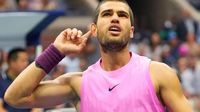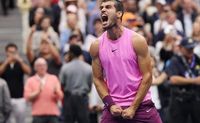Carlos Alcaraz has once again etched his name into tennis history, delivering a masterclass performance to clinch his second US Open title and sixth Grand Slam trophy at just 22 years old. On Sunday, September 7, 2025, at the iconic Arthur Ashe Stadium, Alcaraz toppled defending champion and World No. 1 Jannik Sinner in a gripping four-set final, 6-2, 3-6, 6-1, 6-4. This latest triumph not only cements Alcaraz’s status as the sport’s dominant force but also marks a changing of the guard atop the ATP rankings, as the Spaniard dethrones Sinner to reclaim the world’s top spot.
The anticipation for this final was sky-high, and for good reason. For the first time in modern tennis history, the same two men—Alcaraz and Sinner—battled in three Grand Slam finals in a single calendar year. Tennis fans have been treated to a rivalry that’s both fierce and respectful, with each player pushing the other to new heights. Alcaraz had previously bested Sinner in a five-hour French Open epic, while Sinner avenged that loss with a clinical display at Wimbledon. The US Open decider was the rubber match, and it was Alcaraz who seized the spotlight in New York.
The match itself was delayed by 30 minutes, not due to rain or technical issues, but because President Donald Trump attended, becoming the first sitting US President to grace the US Open in a quarter-century. The added security led to TSA-style checks, causing hundreds of fans to miss the electric opening moments. When Trump appeared on the stadium’s four jumbotrons, he was met with a chorus of boos, contrasting sharply with the thunderous applause for music legend Bruce Springsteen, also in attendance. The star-studded crowd—including Pink, Lindsay Lohan, Kevin Hart, and Ben Stiller—set the stage for an unforgettable afternoon.
From the outset, Alcaraz dictated terms. He broke Sinner’s serve in a marathon eight-minute opening game, immediately applying pressure and signaling his intent. Sinner, usually the picture of consistency, was rattled—committing nine unforced errors in the first set alone. Alcaraz, by contrast, was nearly flawless, making just two unforced errors and racking up 11 winners. The Spaniard’s aggressive play paid dividends as he raced through his service games, barely giving Sinner a sniff.
Yet, as so often happens in tennis, momentum shifted. Sinner, bidding to become the first man since Roger Federer in 2008 to defend the US Open crown, found his rhythm in the second set. He broke Alcaraz to love with a series of spectacular points and suddenly looked impregnable behind his own serve. Alcaraz, for a brief spell, faltered—producing 11 unforced errors in the set. Sinner capitalized, drawing level and giving the Arthur Ashe crowd hope for another five-set classic between these two titans.
But Alcaraz was in no mood for extended drama. He came out firing in the third, breaking Sinner at the first opportunity after the Italian sent a routine shot wide. Sinner, visibly frustrated, sent a ball skyward in exasperation. The Spaniard’s relentless pressure and variety—mixing powerful forehands with deft drop shots—kept Sinner off balance. Alcaraz finished the third set with just two unforced errors, while Sinner’s game began to unravel. The 6-1 scoreline reflected Alcaraz’s utter dominance in that stretch.
Into the fourth set, the pattern continued. Alcaraz broke Sinner midway through, aided by a double fault and a wild forehand from his opponent. Sinner, to his credit, fought valiantly, saving two championship points as Alcaraz served for the match. The tension was palpable—could Sinner mount a comeback? Not this time. On his third championship point, Alcaraz unleashed a 131-m.p.h. ace that Sinner could barely touch, sealing the match in two hours and 42 minutes. Alcaraz spread his arms in triumph, then shared a warm embrace with Sinner at the net.
Statistically, Alcaraz’s performance was jaw-dropping. He finished with 10 aces to Sinner’s two, doubled his rival’s winner count (42 to 21), and did not commit a single double fault. His serve was rock-solid, and his physical conditioning—showcased by his sleeveless pink shirt and NFL-caliber musculature—was a sight to behold. The Spaniard’s aggressive tactics paid off, as he broke Sinner’s serve multiple times, including four breaks through the fourth set. Sinner, meanwhile, struggled to find his usual rhythm, prompting speculation about potential injury or fatigue, though nothing was confirmed.
With this victory, Alcaraz’s head-to-head record against Sinner improves to 10-5, having won seven of their last eight encounters. The Spaniard now boasts six Grand Slam titles, a staggering achievement for someone so young. The 2025 season has been defined by the Alcaraz-Sinner rivalry, with the duo splitting the four majors—Alcaraz taking the French and US Opens, Sinner capturing Wimbledon and reaching all four major finals, a feat matched only by legends like Rod Laver, Roger Federer, and Novak Djokovic.
Off the court, the final was a spectacle, with celebrities and dignitaries adding to the occasion’s grandeur. But it was Alcaraz’s brilliance that shone brightest, avenging his Wimbledon loss and reclaiming the world No. 1 ranking. As he joked on court after the match, “I’m seeing you more than my family,” a nod to the frequency and intensity of his battles with Sinner.
For tennis fans, the emergence of Alcaraz and Sinner as the sport’s leading lights has softened the blow of the Federer-Nadal era ending. There’s little doubt that, health permitting, these two will continue to dominate for years to come. With each Grand Slam final, they raise the bar higher, thrilling audiences and redefining what’s possible on the court.
As the sun set over Arthur Ashe Stadium, Carlos Alcaraz stood tall—US Open champion once again, world No. 1, and the undisputed star of a new era in men’s tennis. The sport’s future looks brighter than ever.






